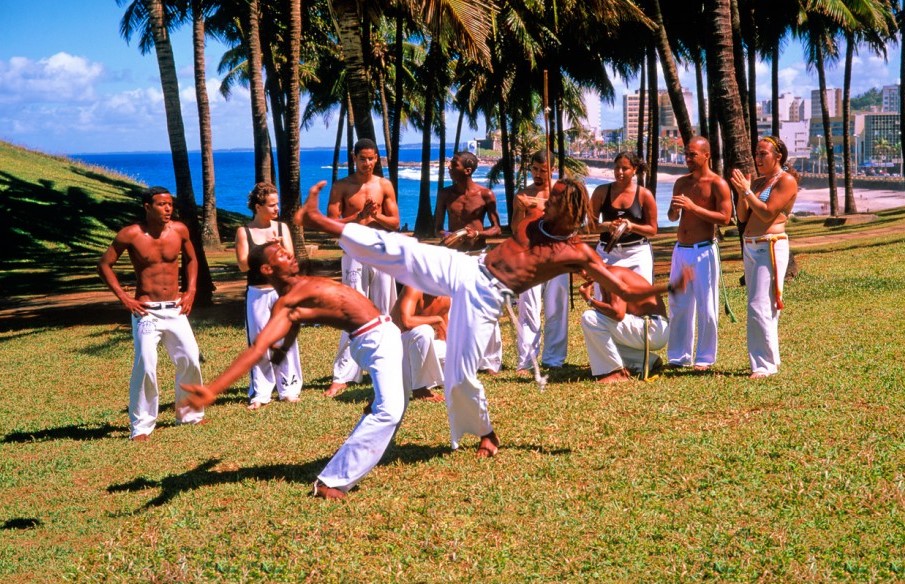Unfolding before your eyes is a spectacle of rhythm, acrobatics, and cultural heritage. Enter the world of Capoeira, a uniquely Brazilian art form that has been captivating hearts and minds across the globe. Recognized as an Intangible Cultural Heritage by UNESCO, Capoeira is more than just a martial art or a dance; it is a symbol of resistance, unity, and cultural identity. This write-up aims to delve into the fascinating history and global impact of Capoeira.
Born out of the struggle for freedom by African slaves in Brazil, Capoeira has evolved into a blend of martial arts, dance, music, and folklore. Our exploration will guide you through the enchanting history and rich traditions of Capoeira, highlighting its significance as a tool for social integration and cultural preservation. We will also pay homage to the masters of the art form, who have played a pivotal role in passing down this rich tradition through generations.
In an increasingly globalized world, Capoeira has transcended national boundaries, uniting people from diverse backgrounds. We will take a closer look at the worldwide impact of Capoeira, capturing the essence of its influence in shaping societies and cultures far beyond Brazil’s borders. From Europe to Asia, Capoeira is breaking barriers and fostering international solidarity through its captivating rhythm and movement.
Lastly, we will highlight the recognition of Capoeira by UNESCO as an Intangible Cultural Heritage. A testament to its historical significance and universal appeal, this recognition has elevated Capoeira’s status on the global stage, contributing to its conservation and promotion. Stay with us as we journey through the colorful world of Capoeira, a cultural treasure uniting the world.
The Cultural Significance of Capoeira
Capoeira is not just a martial art; it is a vibrant expression of Afro-Brazilian culture. It has its roots in the historical struggle of African slaves in Brazil, who created it as a form of resistance. Recognizing the profound significance of Capoeira in representing the history, culture, and resilience of a people, UNESCO declared it an Intangible Cultural Heritage of Humanity in 2014.
The Evolution of Capoeira
Initially, Capoeira was a survival tool during the colonial era in Brazil. Slaves used it as a means of self-defense and resistance against their oppressors. Over time, it evolved into a blend of dance, acrobatics, and music, embodying a spirit of freedom and cultural identity. Today, Capoeira’s unique combination of martial arts, dance, and music is enjoyed and practiced worldwide.
Capoeira’s Impact on Global Unity
Capoeira’s recognition by UNESCO has contributed significantly to its global spread. It is now practiced in over 150 countries, creating a global community united by a shared appreciation of this rich cultural heritage. Capoeira transcends national boundaries and ethnic divisions, fostering a sense of unity and mutual respect among practitioners.
Capoeira and Global Events
Capoeira has been showcased in numerous international events, further enhancing its global recognition. These include the World Capoeira Championships and the Red Bull Paranauê, a prestigious event that brings together Capoeira practitioners from all over the world.
The Role of Capoeira in Promoting Cultural Exchange
Capoeira’s global spread has led to significant cultural exchange. It enables people from diverse cultural backgrounds to learn about Afro-Brazilian history and culture. This cultural exchange fosters mutual understanding and respect, breaking down barriers and promoting unity.
The Influence of Capoeira in Other Spheres
Beyond the cultural realm, Capoeira has also influenced other spheres. Its unique blend of movements and rhythm has inspired numerous fitness regimes and dance styles. It has also found its way into popular culture, featuring in movies, TV shows, and video games.

Final Thoughts
In conclusion, Capoeira is not merely a form of martial art; it’s a potent symbol of Afro-Brazilian culture, and a global testament to human resilience and creativity. Its recognition by UNESCO as an Intangible Cultural Heritage of Humanity underlines its significant cultural, historical, and societal value. From its origins as a survival tool among African slaves in Brazil, it has transformed into a compelling blend of martial arts, dance, and music, appreciated and practiced across the globe.
Beyond just being an entertaining spectacle, Capoeira has a transformative impact on global unity. Its appeal, transcending ethnic divisions and national borders, has brought together people from over 150 countries, creating a global community tied together by a shared love for this cultural treasure. The worldwide dissemination of Capoeira has also facilitated cultural exchange, enabling individuals from diverse backgrounds to learn about and appreciate Afro-Brazilian history and culture.
Moreover, Capoeira’s influence extends into various spheres, inspiring fitness regimes, dance styles, and even finding its way into mainstream media. This richly layered martial art encapsulates the spirit of cultural exchange, resilience, and unity. Therefore, its global recognition and popularity serve as a celebration of cultural diversity and human creativity. Whether featured in international events or integrated into daily fitness routines, Capoeira continues to captivate and unite people worldwide.
- Capoeira is a vibrant expression of Afro-Brazilian culture recognized by UNESCO as an Intangible Cultural Heritage of Humanity.
- Capoeira has evolved from a survival tool for slaves into a unique blend of martial arts, dance, and music.
- Capoeira is practiced in over 150 countries, fostering global unity and cultural exchange.
- Capoeira has been showcased in international events and has influenced fitness regimes, dance styles, and popular culture.
